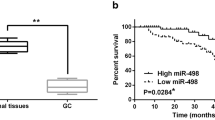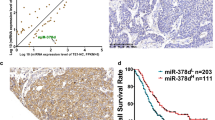Abstract
Chemotherapy can prevent metastasis and recurrence of gastric cancer (GC), and is a well supplement for operation. But, chemotherapy resistance has severely restricted the application of chemotherapy. This study aimed to investigate the regulatory roles and molecular mechanism of miR-16-1 to the chemosensitivity to adriamycin in GC. In this study, the expression of miR-16-1 and FUBP1 was down-regulated and up-regulated respectively in adriamycin-resistant GC tissues and cell lines, and represented a negative relationship between them. MiR-16-1 could silence FUBP1 directly and specifically, FUBP1 was a target gene of miR-16-1. Silence of FUBP1 inhibited the half maximal inhibitory concentration (IC50) of SGC7901/AR cell line to adriamycin, chemosensitivity enhanced significantly. Moreover, FUBP1 silence in SGC7901/AR cell line also inhibited proliferation and invasion, and advanced cell apoptosis. To sum up, the expression of miR-16-1 was positively related with the chemosensitivity of GC to adriamycin, and miR-16-1 could targeted silence FUBP1 to advance the chemosensitivity to adriamycin in GC, which might be a novel potential therapeutic target for GC.



Similar content being viewed by others
References
Sugano K (2015) Screening of gastric cancer in Asia. Best Pract Res Clin Gastroenterol 29(6):895–905
Newton AD, Datta J, Loaiza-Bonilla A, Karakousis GC, Roses RE (2015) Neoadjuvant therapy for gastric cancer: current evidence and future directions. J Gastrointest Oncol 6(5):534–543
Piletič K, Kunej T (2016) MicroRNA epigenetic signatures in human disease. Arch Toxicol 90(10):2405–2419
Mohammadi A, Mansoori B, Baradaran B (2016) The role of microRNAs in colorectal cancer. Biomed Pharmacother 84:705–713
Sekhon K, Bucay N, Majid S, Dahiya R, Saini S (2016) MicroRNAs and epithelial-mesenchymal transition in prostate cancer. Oncotarget 7(41):67597–67611
Yang Y, Zhang P, Zhao Y, Yang J, Jiang G, Fan J (2016) Decreased MicroRNA-26a expression causes cisplatin resistance in human non-small cell lung cancer. Cancer Biol Ther 17(5):515–525
Li J, Ju J, Ni B, Wang H (2016) The emerging role of miR-506 in cancer. Oncotarget 7(38):62778–62788
Pekarsky Y, Croce CM (2015) Role of miR-15/16 in CLL. Cell Death Differ 22(1):6–11
Wang W, Chen J, Dai J, Zhang B, Wang F, Sun Y (2016) MicroRNA-16-1 inhibits tumor cell proliferation and induces apoptosis in A549 non-small cell lung carcinoma cells. Oncol Res 24(5):345–351
Sam S, Sam MR, Esmaeillou M, Safaralizadeh R (2016) Effective targeting Survivin, caspase-3 and MicroRNA-16-1 expression by methyl-3-pentyl-6-methoxyprodigiosene triggers apoptosis in colorectal cancer stem-like cells. Pathol Oncol Res 22(4):715–723
Zhang C, Fang X, Li W, Shi Q, Wu L, Chen X, Huang Z, Wu P, Wang Z, Liao Z (2014) Influence of recombinant lentiviral vector encoding miR-15a/16-1 in biological features of human nasopharyngeal carcinoma CNE-2Z cells. Cancer Biother Radiopharm 29(10):422–427
Li X, Ling N, Bai Y, Dong W, Hui GZ, Liu D, Zhao J, Hu J (2013) MiR-16-1 plays a role in reducing migration and invasion of glioma cells. Anat Rec (Hoboken) 296(3):427–432
Cai CK, Zhao GY, Tian LY, Liu L, Yan K, Ma YL, Ji ZW, Li XX, Han K, Gao J, Qiu XC, Fan QY, Yang TT, Ma BA (2012) miR-15a and miR-16-1 downregulate CCND1 and induce apoptosis and cell cycle arrest in osteosarcoma. Oncol Rep 28(5):1764–1770
Wang T, Hou J, Li Z, Zheng Z, Wei J, Song D, Hu T, Wu Q, Yang JY, Cai JC (2017) miR-15a-3p and miR-16-1-3p negatively regulate Twist1 to repress gastric cancer cell invasion and metastasis. Int J Biol Sci 13(1):122–134
Kang W, Tong JH, Lung RW, Dong Y, Zhao J, Liang Q, Zhang L, Pan Y, Yang W, Pang JC, Cheng AS, Yu J, To KF (2015 Feb 22) Targeting of YAP1 by microRNA-15a and microRNA-16-1 exerts tumor suppressor function in gastricadenocarcinoma. Mol Cancer 14:52. doi:10.1186/s12943-015-0323-3
Shang C, Guo Y, Zhang J, Huang B (2016) Silence of long noncoding RNA UCA1 inhibits malignant proliferation and chemotherapy resistance to adriamycin in gastric cancer. Cancer Chemother Pharmacol 77(5):1061–1067
Lu C, Shan Z, Li C, Yang L (2017) MiR-129 regulates cisplatin-resistance in human gastric cancer cells by targeting P-gp. Biomed Pharmacother 86:450–456
Cao W, Wei W, Zhan Z, Xie Y, Xiao Q (2016) MiR-1284 modulates multidrug resistance of gastric cancer cells by targeting EIF4A1. Oncol Rep 5:2583–2591
Li H, Wang Z, Zhou X, Cheng Y, Xie Z, Manley JL, Feng Y (2013) Far upstream element-binding protein 1 and RNA secondary structure both mediate second-step splicing repression. Proc Natl Acad Sci U S A 110:E2687–E2695
Olanich ME, Moss BL, Piwnica-Worms D, Townsend RR, Weber JD (2011) Identification of FUSE-binding protein 1 as a regulatory mRNA-binding protein that represses nucleophosmin translation. Oncogene 30:77–86
Samarin J, Laketa V, Malz M, Roessler S, Stein I, Horwitz E, Singer S, Dimou E, Cigliano A, Bissinger M, Falk CS, Chen X, Dooley S, Pikarsky E, Calvisi DF, Schultz C, Schirmacher P, Breuhahn K (2016) PI3K/AKT/mTOR-dependent stabilization of oncogenic far-upstream element binding proteins in hepatocellular carcinoma cells. Hepatology 63(3):813–826
Sheng H, Ying L, Zheng L, Zhang D, Zhu C, Wu J, Feng J, Su D (2015) Down expression of FBP1 is a negative prognostic factor for non-small-cell lung cancer. Cancer Investig 33(5):197–204
Liu ZH, Hu JL, Liang JZ, Zhou AJ, Li MZ, Yan SM, Zhang X, Gao S, Chen L, Zhong Q, Zeng MS (2015) Far upstream element-binding protein 1 is a prognostic biomarker and promotes nasopharyngeal carcinoma progression. Cell Death Dis 6:e1920
Hong Y, Shi Y, Shang C, Xue Y, Liu Y (2016) Influence of far upstream element binding protein 1 gene on chemotherapy sensitivity in human U251 glioblastoma cells. Arch Med Sci 12(1):156–162
Ding Z, Liu X, Liu Y, Zhang J, Huang X, Yang X, Yao L, Cui G, Wang D (2015) Expression of far upstream element (FUSE) binding protein 1 in human glioma is correlated with c-Myc and cell proliferation. Mol Carcinog 54(5):405–415
Yang L, Zhu JY, Zhang JG, Bao BJ, Guan CQ, Yang XJ, Liu YH, Huang YJ, Ni RZ, Ji LL (2016) Far upstream element-binding protein 1 (FUBP1) is a potential c-Mycregulator in esophageal squamous cell carcinoma (ESCC) and its expression promotes ESCC progression. Tumour Biol 37(3):4115–4126
Acknowledgements
This work was supported by the National Nature Science Foundation of China (81272716).
Author information
Authors and Affiliations
Contributions
DZ and LS participated in the study design and drafted the manuscript. DZ and YZ carried out the in vitro studies and performed the statistical analysis. DZ conceived of the study and helped to draft the manuscript. All authors read and approved the final manuscript.
Corresponding author
Ethics declarations
Conflict of Interest
The authors declare that they have no competing interests.
Rights and permissions
About this article
Cite this article
Zhao, D., Zhang, Y. & Song, L. MiR-16-1 Targeted Silences Far Upstream Element Binding Protein 1 to Advance the Chemosensitivity to Adriamycin in Gastric Cancer. Pathol. Oncol. Res. 24, 483–488 (2018). https://doi.org/10.1007/s12253-017-0263-x
Received:
Accepted:
Published:
Issue Date:
DOI: https://doi.org/10.1007/s12253-017-0263-x




